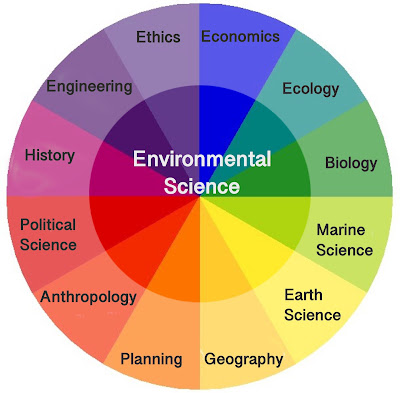Defining Environmental Science
Here's how the popular textbooks we use define Environmental Science.
Miller and Spoolman's definition used in 2018-2020 is succinct:
Environmental science is a study of connections in nature. It is an interdisciplinary study of (1) how the earth (nature) works and has survived and thrived, (2) how humans interact with the environment, and (3) how we can live more sustainably. It strives to answer several questions: What environmental problems do we face? How serious are they? How do they interact? What are their causes? How has nature solved such problems? How can we solve such problems? To answer such questions, environmental science integrates information and ideas from fields such as biology, chemistry, geology, geography, economics, political science, and ethics.
Miller, G.T. & Spoolman, S.E. 2020. Living in the environment, Boston, Cengage Learning.
Environmental science is a study of how the earth works, how we interact with the earth, and how to deal with environmental problems.
Raven and Berg (9th Edition - 2014) says:
Environmental science encompasses the many interconnected issues involving human population, Earth’s natural resources, and environmental pollution. Environmental science combines information from many disciplines, such as biology, geography, chemistry, geology, physics, economics, sociology, demography (the study of populations), cultural anthropology, natural resources management, agriculture, engineering, law, politics, and ethics. Ecology , the branch of biology that studies the interrelationships between organisms and their environment, is a basic tool of environmental science.
Environmental scientists try to establish general principles about how the natural world functions. They use these principles to develop viable solutions to environmental problems— solutions based as much as possible on scientific knowledge. Environmental problems are generally complex, so our understanding of them is often less complete than we would like it to be. Environmental scientists are often asked to reach a consensus before they fully understand the systems that they study. As a result, they often make recommendations based on probabilities rather than precise answers.
Many of the environmental problems discussed in this book are serious, but environmental science is not simply a “doom-and gloom” listing of problems coupled with predictions of a bleak future. To the contrary, its focus is, and our focus as individuals and as world citizens should be, on identifying, understanding, and finding better ways to manage the stresses that human activities place on environmental resources and systems.
Environmental science: The interdisciplinary study of humanity’s relationship with other organisms the nonliving physical environment.
Raven, Peter H., et al. Environment, 9th Edition, Wiley, 2014.
Last, let's look at Withgott and Lapsota.
Environmental science is the study of how the natural world works, how our environment affects us, and how we affect our environment. We need to understand how we interact with our environment in order to devise solutions to our most pressing challenges. It can be daunting to reflect on the sheer magnitude of environmental dilemmas that confront us today, but these problems also bring countless opportunities for creative solutions.
Environmental scientists study the issues most centrally important to our world and its future. Right now, global conditions are changing more quickly than ever. Right now, through science, we are gaining knowledge more rapidly than ever. And right now, the window of opportunity for acting to solve problems is still open. With such bountiful opportunities, this particular moment in history is indeed an exciting time to be alive— and to be studying environmental science.
Withgott, Jay H., and Matthew Laposata. Environment: The Science behind the Stories, Global Edition, Pearson Education Limited, 2015.
Further from Withgott and Lapsota:
The Nature of Environmental Science
Environmental scientists aim to comprehend how Earth’s natural systems function, how these systems affect people, and how we are influencing those systems. Many environmental scientists are motivated by a desire to develop solutions to environmental problems. These solutions (such as new technologies, policy decisions, or resource management strategies) are applications of environmental science. The study of such applications and their consequences is, in turn, also part of environmental science.
Environmental science is interdisciplinary
Studying our interactions with our environment is a complex endeavor that requires expertise from many disciplines, including ecology, earth science, chemistry, biology, geography, economics, political science, demography, ethics, and others. Environmental science is thus an interdisciplinary field —one that borrows techniques from multiple disciplines and brings their research results together into a broad synthesis (see figure, adapted).
Traditional established disciplines are valuable because their scholars delve deeply into topics, developing expertise in particular areas and uncovering new knowledge. In contrast, interdisciplinary fields are valuable because their practitioners consolidate and synthesize the specialized knowledge from many disciplines and make sense of it in a broad context to better serve the multifaceted interests of society.
Environmental science is especially broad because it encompasses not only the natural sciences (disciplines that examine the natural world), but also the social sciences (disciplines that address human interactions and institutions). Most environmental science programs focus more on the natural sciences, whereas programs that emphasize the social sciences often use the term environmental studies. Whichever approach one takes, these fields bring together many diverse perspectives and sources of knowledge.
Just as an interdisciplinary approach to studying issues can help us better understand them, an integrated approach to addressing environmental problems can produce effective solutions for society. For example, we used to add lead to gasoline to make cars run more smoothly, even though researchers knew that lead emissions from tailpipes caused health problems, including brain damage and premature death.


Comments
Post a Comment